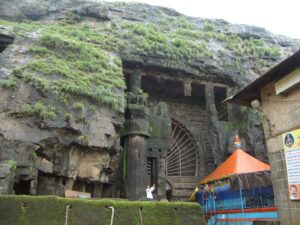
Karla is one of the most famous centers of early rock-cut architecture and has received much attention of scholars and commoners alike. This group of rock excavations is not that elaborate when compared to its counterparts at Ajanta and Ellora. However, the grand Chaityagriha of Karla is the grandest and the largest of all the chaitya-grihas of India.
Karla is situated in Maval Taluka of Pune district. The location of Karla is also important for its rich embellishments, it is on the ancient highway connecting seaports of Kalyan and Sopara to the cities located inland.
The caves are excavated nearly 100 metres on a high spur of the chain of hills on the north flank of the Indrayani valley. The chaityagriha is the most prominent and hence it dominates the remaining excavations. A wide and flat open area in front of the chaityagriha could have provided an ideal place for large gatherings of the followers of Buddhism. The wide land narrows down on the south and runs almost as a ledge path, turns east and continues up to the edge of the cliff. A few isolated excavations could also been seen near this ledge path.
The monasteries at Karla could be datable between circa 60-40 B.C. and 4th century A.D. Except from three excavations of Mahayana phase the remaining belong to the Hinayana phase. It seems that the entire monastic complex at Karla was conceived as a single design. The caves were caused from the donations and support of a group of assorted individuals. This includes a prince of Maharathi family; merchants and merchant guilds; monks and nuns and lay devotees including men and women. Persons practically from every strata of the society contributed towards the establishment of this complex thus indicating its importance in the Buddhist world.
The Chaitya Hall is astounding with its 45m length and 14m height, making it the largest rock cut chaityas in the nation. It has gorgeous sculptures of animals such as lions and elephants. These carvings are ornamented with metal jewelleries and ivory tusks. The bottom of the hall has the form of water jar above which are 37 octagonal pillars erected. The facade is engraved out of teakwood with an arc in the form of a horse shoe.
The object of worship is the stupa at the rear end of the chaityagriha. The stupa consists of a cylindrical drum rising in two stages. A hemispherical dome rises over the drum which supports a cubical harmika and a seven stepped inverted square pyramid over it. Over the pyramid is placed a wooden chhatri with a shaft through a hole pierced into it.
The chaityagriha is entered through a screen wall erected in front of the verandah, which in turn has three entrances, the central one opening into the nave and the other two, into the flanking aisles. The side walls of the verandah and inner face of the screen wall are extensively decorated with sculptures. The front wall of the verandah is also profusely decorated which is executed in two parts. The lower portion consists of a row of railing pattern and above which is six mithuna figures rising up to the level of the lintels. The portion above the doorways is decorated with a series of miniature chaitya windows imitating the huge chaitya window. These miniature windows are connected through a vedika and a roll cornice. This pattern extends throughout the entire width of the façade of the hall. The huge chaitya window mentioned above provides good light source to light the stupa and the pillars of the grand chaityagriha.
The chaityagriha at Karla is also unique as it is one among the two chaityagrihas in western Deccan which has huge lion pillars in front, the other being Kanheri. This pillar is of the Asokan type with a huge sixteen sided shaft rising over a platform. The shaft is surmounted by an inverted bell member followed by flat surface and inverted stepped pyramidal plates. Four lions command the top of this pillar. This pillar is located to the right of the chaityagriha. Similar pillar should have existed on its left, for which evidence is seen in the form of a short stump.
Source: http://asi.nic.in/asi_monu_tktd_maha_karlacaves.asp


